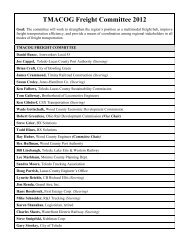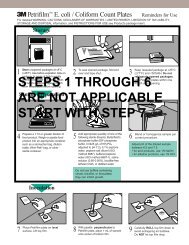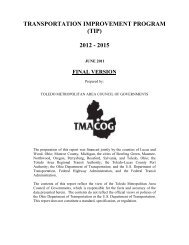Stormwater Management Standards Manual - Toledo Metropolitan ...
Stormwater Management Standards Manual - Toledo Metropolitan ...
Stormwater Management Standards Manual - Toledo Metropolitan ...
Create successful ePaper yourself
Turn your PDF publications into a flip-book with our unique Google optimized e-Paper software.
6.4.2 Dry Weather Field Screening<br />
The field screening technique recommended for an IDDE program is the Outfall Reconnaissance<br />
Inventory or ORI. The ORI is a stream walk designed to inventory and measure storm drain outfalls, and<br />
find and correct continuous and intermittent discharges without in-depth laboratory analysis. There are<br />
four recognized steps to the ORI. As communities acquire more monitoring data, they should consider<br />
creating a chemical fingerprint library, which is a database of the chemical make-up of the many different<br />
flow types in the community. Over time, chemical library data can help a community better understand<br />
the potential pollutant loads delivered to receiving waters from various generating activities.<br />
Acquire necessary mapping, equipment and staff: Street maps may be use for the initial assessment<br />
and minimal field equipment is required.<br />
Determine when to conduct field screening: The best time to conduct field screening is during dry<br />
season and leaf-off conditions. It is best to conduct field screening after a dry period of at least 48 hours<br />
while the ground water levels are low.<br />
Identify where to conduct field screening: The MS4 requires that all outfalls be screened in the permit<br />
period. Communities should begin in areas with a high illicit discharge potential.<br />
Conduct field screening: An illicit discharge detection and elimination program will be more effective and<br />
efficient in the long run if all outfalls are marked and photographed. During the ORI communities should<br />
collect data on the characteristics of every outfall.<br />
There are four basic sensory indicators that field crews should look for in conjunction with a flowing<br />
outfall. Sensory indicators can be detected by smell or sight and do not require measurement<br />
equipment.<br />
Odor: Field crews should record any odor coming from the outfall and give the outfall a severity rating.<br />
A severity rating of one means that the odor is faint or the crew cannot agree on its presence or origin.<br />
A score of tow indicates a moderate odor within the pipe. A score of three is assigned if the odor is so<br />
strong that the crew smells it a considerable distance away from the outfall. Field crews should take<br />
care to make sure that the odor originates from the outfall. Sometimes shrubs, trash, carrion or even the<br />
spray paint used to mark the outfall can confuse the nose.<br />
Color: The color of a discharge can be classified as clear, slightly tinted or intense. The best way to<br />
measure color is to collect the discharge in a clear sample bottle and hold it up to the light. Field crews<br />
should also look for downstream plumes of color that appear to be associated with the outfall. Color can<br />
also help identify industrial discharges.<br />
Turbidity: Turbidity is the measure of the cloudiness of the water. Like color, turbidity is best observed<br />
in a clear sample bottle. Field crews should also look for turbidity in the plunge pool and note any<br />
downstream turbidity plumes that appear to be related to the outfall.<br />
Floatables: The presence of floatable materials is determined visually. Sewage, oil sheen, and suds are<br />
all examples of floatable indicators. Sewage should automatically be assigned a severity score of three<br />
since no other source looks quite like it. Surface oil sheens are ranked based on their thickness and<br />
coverage. In some cases, surface sheens may not be related to oil discharges, but instead are created<br />
by in-stream processes. A thick or swirling sheen associated with a petroleum-like odor may be<br />
diagnostic of an oil discharge. Suds are rated based on their foaminess and staying power. Thick foam<br />
that travels many feet before it breaks up is given a severity rating of three. Suds that break up quickly<br />
may simply reflect water turbulence, and do not necessarily have an illicit origin. Decaying organic<br />
matter creates naturally occurring foams in some streams. Suds that are accompanied by a strong<br />
Third Edition <strong>Stormwater</strong> <strong>Standards</strong> <strong>Manual</strong> September 2008 Page 112
















